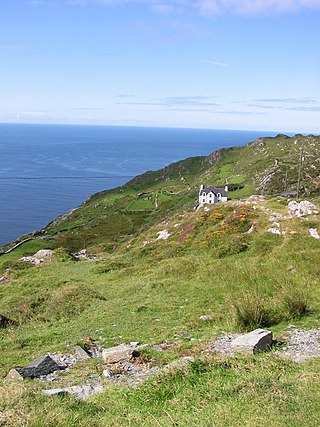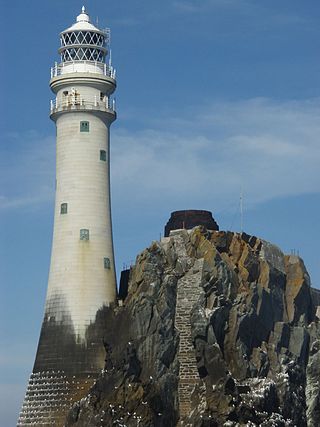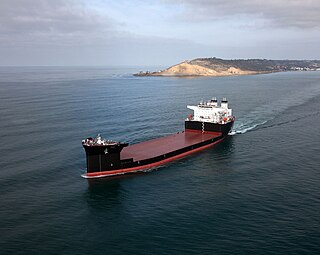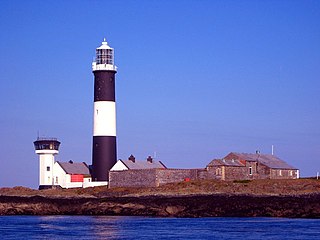
Crookhaven is a village in County Cork, Ireland, on the most southwestern tip of the island of Ireland. With an out-of-season population of about sixty, it swells in the summer season to about four hundred, when the occupants of the seasonal holiday homes arrive.

Sheep's Head, also known as Muntervary, is the headland at the end of the Sheep's Head peninsula situated between Bantry Bay and Dunmanus Bay in County Cork, Ireland.

Fastnet Lighthouse is a 54-metre-tall (177 ft) lighthouse situated on the remote Fastnet Rock in the Atlantic Ocean. It is the most southerly point of Ireland and lies 6.5 kilometres (4.0 mi) southwest of Cape Clear Island and 13 kilometres (8.1 mi) from County Cork on the Irish mainland. The current lighthouse is the second to be built on the rock and is the tallest in Ireland.

The Northern Lighthouse Board (NLB) is the general lighthouse authority for Scotland and the Isle of Man. It is a non-departmental public body responsible for marine navigation aids around coastal areas.

The Louisiana Offshore Oil Port (LOOP) is a deepwater port in the Gulf of Mexico 29 kilometers off the coast of Louisiana near the town of Port Fourchon. LOOP provides tanker offloading and temporary storage services for crude oil transported on some of the largest tankers in the world. Most tankers offloading at LOOP are too large for U.S. inland ports. LOOP handles 13 percent of the nation's foreign oil, about 1.2 million barrels (190,000 m3) a day, and connects by pipeline to 50 percent of the U.S. refining capability.

The T2 tanker, or T2, was a class of oil tanker constructed and produced in large numbers in the United States during World War II. Only the T3 tankers were larger "navy oilers" of the period. Some 533 T2s were built between 1940 and the end of 1945. They were used to transport fuel oil, diesel fuel, gasoline and sometimes black oil-crude oil. Post war many T2s remained in use; like other hastily built World War II ships pressed into peacetime service, there were safety concerns. As was found during the war, the United States Coast Guard Marine Board of Investigation in 1952 stated that in cold weather the ships were prone to metal fatigue cracking, so were "belted" with steel straps. This occurred after two T2s, Pendleton and Fort Mercer, split in two off Cape Cod within hours of each other. Pendleton's sinking is memorialized in the 2016 film The Finest Hours. Engineering inquiries into the problem suggested the cause was poor welding techniques. It was found the steel was not well suited for the new wartime welding construction. The high sulfur content made the steel brittle and prone to metal fatigue at lower temperatures.

Whiddy Island is an island near the head of Bantry Bay in Ireland. It is approximately 5.6 km (3.5 mi) long and 2.4 km (1.5 mi) wide. The topography comprises gently-rolling glacial till, with relatively fertile soil. As late as 1880 the island had a resident population of around 450, mainly engaged in fishing and small-scale farming, but today the population has reduced to approximately 30 people. Previously home to Whiddy Island Naval Air Station, the island is noted for its oil terminal facilities – and the related Whiddy Island Disaster.

Hammac was a steam tank ship built in 1920–1921 by Bethlehem Shipbuilding Corporation of Alameda for the United States Shipping Board as part of the wartime shipbuilding program of the Emergency Fleet Corporation (EFC) to restore the nation's Merchant Marine. Early in 1923 the vessel together with two other tankers was sold to General Petroleum Corporation and renamed Emidio. The tanker spent the vast majority of her career carrying oil along the West Coast of the United States as well as between West and East coast. In December 1941 she was shelled and damaged by the Japanese submarine I-17 and eventually wrecked with a loss of five crewmen.

The Whiddy Island disaster, also known as the Betelgeuse incident or Betelgeuse disaster, occurred on 8 January 1979, around 1:00 am, when the oil tanker Betelgeuse exploded in Bantry Bay, at the offshore jetty for the oil terminal at Whiddy Island, Ireland. The explosion was attributed to the failure of the ship's structure during an operation to discharge its cargo of oil. The tanker was owned by Total S.A., and the oil terminal was owned by Gulf Oil.

The Hook Lighthouse is a building situated on Hook Head at the tip of the Hook Peninsula in County Wexford, in Ireland. It is one of the oldest lighthouses in the world and the second oldest operating lighthouse in the world, after the Tower of Hercules in Spain. It is operated by the Commissioners of Irish Lights, the Irish lighthouse authority, and marks the eastern entrance to Waterford Harbour. The current structure has stood for over 800 years.

The Kish Bank is a shallow sand bank approximately 11 kilometres (7 mi) off the coast of Dublin, in Ireland. It is marked by the Kish Lighthouse, a landmark visible to sailors and ferry passengers passing through Dublin Bay and Dún Laoghaire harbour.

An Expeditionary Transfer Dock (ESD), formerly the Mobile Landing Platform (MLP), is designed to be a semi-submersible, flexible, modular platform providing the US Navy with the capability to perform large-scale logistics movements such as the transfer of vehicles and equipment from sea to shore. These ships significantly reduce the dependency on foreign ports and provide support in the absence of port availability. The class also houses a sub-class variant called the Expeditionary Mobile Base (ESB), formerly the Afloat Forward Staging Base (AFSB).

USS Lewis B. Puller (ESB-3), is the first purpose-built expeditionary mobile base vessel for the United States Navy, and the second ship to be named in honor of Chesty Puller. The lead ship in her class of expeditionary mobile bases, she is also a sub-variant of the Montford Point-class expeditionary transfer docks. Lewis B. Puller replaced USS Ponce with the U.S. Fifth Fleet in the Persian Gulf in late 2017.

The Wild Atlantic Way is a tourism trail on the west coast, and on parts of the north and south coasts, of Ireland. The 2,500 km driving route passes through nine counties and three provinces, stretching from County Donegal's Inishowen Peninsula in Ulster to Kinsale, County Cork, in Munster, on the Celtic Sea coast.

Samuel Q. Brown was a steam tanker built in 1920–1921 by Merchant Shipbuilding Corporation of Chester for Tide Water Oil Co., a subsidiary of Standard Oil, with intention of operating between New York and the oil-producing ports of the southern United States and Mexico.
India Arrow was a steam tanker built in 1921 by Bethlehem Shipbuilding Corporation of Quincy for Standard Oil Co., with intention of transporting oil and petroleum products between the United States and the Far East. During the first eight years the tanker was chiefly employed in the Pacific trade, carrying cargo between Gulf ports and a variety of destinations in East Asia. In late 1920s the tanker was moved to serve intercoastal trade routes while still making occasional trips to Asia. In early 1930s she was permanently assigned to trade routes between the Gulf and the ports on the United States East Coast, where she remained for the rest of her career.
Lyman Stewart was a steam tanker built in 1914 by Union Iron Works Company of San Francisco for the Union Oil Company of California, with intention of transporting oil and petroleum products to ports along the West Coast of the United States and Canada. The ship was named after Lyman Stewart, the president of the Union Oil Co. In October 1922 the tanker collided with another steamer, SS Walter Luckenbach, and was beached to avoid sinking but was subsequently declared a total loss.
Swiftstar was a steam tanker built in 1920-1921 by Northwest Bridge & Iron Company of Portland for the Swiftsure Oil Transport Co., a subsidiary of the France & Canada Steamship Co., with intention of transporting oil from foreign ports to refineries along the Gulf and East Coasts of the United States. The ship had short but troubled history. In July 1923 after departing Colón the tanker went missing. Large oil slick, burnt remnants and several lifeboats bearing the ships's name were later found indicating the ship exploded. All 32 people on board were presumed lost.

Mew Island Lighthouse is an active lighthouse within the Copeland Islands of County Down in Northern Ireland. The current 19th-century tower is the most recent in a series of lighthouses that have been built in the islands, which have helped to guide shipping around the archipelago and into Belfast Lough.

The Ardnakinna Lighthouse, is an active aid to navigation located on Bere Island, County Cork at the western entrance to Castletownbere.


















